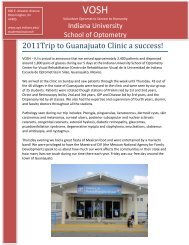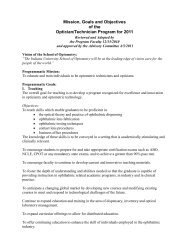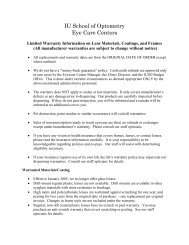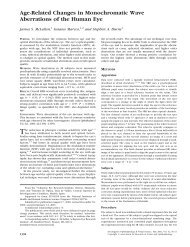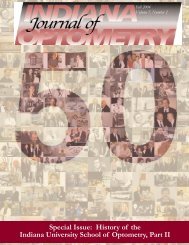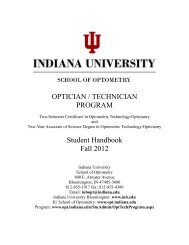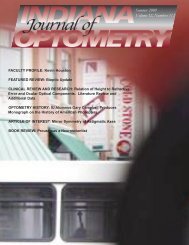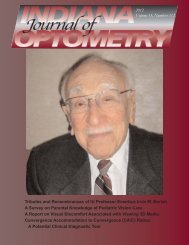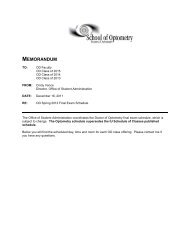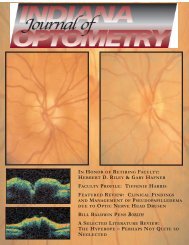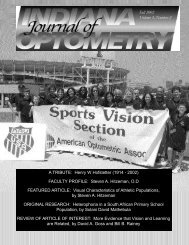Summer 2000 - Indiana University School of Optometry
Summer 2000 - Indiana University School of Optometry
Summer 2000 - Indiana University School of Optometry
Create successful ePaper yourself
Turn your PDF publications into a flip-book with our unique Google optimized e-Paper software.
with uncorrected VA (UCVA) <strong>of</strong> 20/40 or better, and<br />
between 40 and 70% with 20/20 or better UCVAs.<br />
The FDA requires a new laser system to demonstrate<br />
20/40 UCVA in at least 85% <strong>of</strong> treated eyes to qualify<br />
as effective. That is, perhaps 50% <strong>of</strong> LASIK patients<br />
will have to tolerate uncorrected VAs poorer than<br />
20/20 or wear a spectacle or contact lens to achieve<br />
their pre-surgical VA. As many patients with low<br />
levels <strong>of</strong> refractive error now do, these post LASIK<br />
patients with small residual refractive errors generally<br />
choose to leave them uncorrected making the clear<br />
choice <strong>of</strong> convenience over vision quality.<br />
There is one significant complication associated<br />
with efficacy. Since photoablation removes tissue,<br />
there will always be some wound healing process,<br />
and this can and does lead to post-surgical refractive<br />
instability. Since PRK removed the entire epithelium<br />
and Bowman’s layer, the healing process was very<br />
active, and this was the likely cause <strong>of</strong> much <strong>of</strong> the<br />
post surgical instability. The reduced wound healing<br />
response experienced with LASIK results in less postsurgical<br />
instability in Rx, most eyes (e.g. 95%)<br />
experiencing less than 1 diopter change during the<br />
year post surgery. Recent protocols have reduced<br />
the population mean change in Rx to almost zero.<br />
However, some individual eyes do experience<br />
changes during the 6 months post-surgery.<br />
Although LASIK does not require complete regrowth<br />
<strong>of</strong> the corneal epithelium and the wound<br />
healing is reduced, recent studies have observed<br />
increased epithelial thickness anterior to the ablation<br />
indicating some epithelial response to the surgery or<br />
the ablation.<br />
Of course, efficacy will be compromised by any<br />
change in corneal structure following keratomileusis<br />
or photoablation, and the significant reduction in the<br />
thickness <strong>of</strong> the remaining structurally intact cornea<br />
does seem to have an effect. For example, bowing <strong>of</strong><br />
the posterior corneal surface has been reported and<br />
this may reflect structural changes caused by the<br />
removal <strong>of</strong> more than 100 microns with the keratome<br />
and up to 200 microns with photoablation, reducing<br />
the 500 micron thick cornea to approximately only<br />
200 mechanically integrated microns. A significant<br />
correlation between bowing and residual stromal<br />
thickness has been observed when the thickness is<br />
less than 290 microns. The same study concluded<br />
that inaccuracies in the refractive outcome stem<br />
primarily from a combination <strong>of</strong> secondary bowing<br />
and epithelial thickness changes that develop postsurgically.<br />
Leaving less than 250 microns intact is<br />
generally felt to be unsafe.<br />
The primary determinant <strong>of</strong> efficacy is the amount<br />
and spatial distribution <strong>of</strong> tissue ablated. This <strong>of</strong>ten<br />
depends upon proprietary algorithms, which can be<br />
updated to improve efficacy if a procedure has been<br />
shown to either under or over correct. Very simply, if<br />
the pre-ablation anterior corneal curvature is known,<br />
the desired change in refraction determines the<br />
required new curvature and the amount <strong>of</strong> tissue to<br />
be removed. Studies have shown how much tissue<br />
will be ablated by a given amount <strong>of</strong> laser energy<br />
(e.g. 0.1 microns can be removed by a 50 mJ/cm2<br />
excimer laser pulse), but these values vary slightly<br />
from eye to eye depending upon such things as<br />
stromal hydration. An additional source <strong>of</strong> variability<br />
is eye position and eye movements during surgery.<br />
In response to this concern, some laser systems (e.g.<br />
Autonomous flying spot laser) include an eye position<br />
tracking system to effectively stabilize the eye with<br />
respect to the laser. This system corrects for any eye<br />
movements during the procedure, which can last from<br />
few seconds to 60 seconds depending on the amount<br />
<strong>of</strong> tissue to be ablated.<br />
One major advantage <strong>of</strong> PRK over RK is that,<br />
unlike RK, it did not suffer from significant diurnal<br />
fluctuations or the significant hyperopic shifts<br />
associated with high altitudes that plagued RK.<br />
Recent studies by the US military at 14,000 ft. have<br />
confirmed that LASIK eyes do not suffer from the 1.5<br />
diopter hyperopic shifts seen in RK eyes, but if an eye<br />
has had LASIK recently, a hyperopic shift <strong>of</strong> about 0.5<br />
diopters was observed. However, after six months,<br />
no such shift was observed.<br />
Since the mean post-LASIK Rx has approached<br />
zero, it appears that the tissue ablation algorithms<br />
have been optimized. The fact that the majority <strong>of</strong><br />
eyes do not end up emmetropic results from the eyeto-eye<br />
variability in such factors as epithelial growth,<br />
corneal bowing and reaction to the laser. Therefore,<br />
in order to improve the efficacy still further, a two step<br />
surgery may have to be implemented. The second<br />
ablation will fine tune the small errors left after the<br />
first LASIK. However, the second procedure is nearly<br />
as costly as the first and reduces pr<strong>of</strong>it margins.<br />
Such an approach is already used to correct "poor<br />
outcomes" after the initial LASIK procedure.<br />
LASIK Safety<br />
Evaluation <strong>of</strong> safety is more complicated than<br />
assessing efficacy <strong>of</strong> refractive surgery. We can<br />
consider any change to the eye which compromises<br />
vision as a safety problem. There are five general<br />
categories <strong>of</strong> such problems following LASIK: (1)<br />
infections and pathology in response to the surgical<br />
or/and ablative procedures, (2) undesirable wound<br />
healing responses, (3) photoablative changes that<br />
cannot be corrected with standard spectacle or<br />
contact lenses, (4) effects <strong>of</strong> the high energy laser on<br />
other ocular tissues, and (5) optical problems<br />
.........................................................<strong>Indiana</strong> Journal <strong>of</strong> <strong>Optometry</strong> ... <strong>Summer</strong> <strong>2000</strong> ... Vol. 3, No. 1 ... page 7



